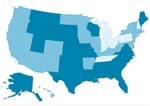Profession
Prescription for pain care: More physicians, more treatment
■ With risks from overprescribing and underprescribing, keys to easing primary care doctors' concerns are better regulations and more education.
By Andis Robeznieks — Posted Dec. 13, 2004
- WITH THIS STORY:
- » Knowing the law can keep you in practice
- » External links
- » Related content
The nearly 75 million Americans who experience chronic pain need help from primary care physicians.
There are about 10,000 physicians who specialize in treating pain, but that's not nearly enough, said one of the nation's leading pain experts, Russell K. Portenoy, MD. Only 5% of patients with the most severe pain ever get to see one of these specialists.
"You have a situation where the math doesn't work," said Dr. Portenoy, chair of the Dept. of Pain Medicine and Palliative Care at New York City's Beth Israel Medical Center.
Internist Scott M. Fishman, MD, president-elect of the American Academy of Pain Medicine, agreed.
"The bottom line is that, even in communities that have a lot of specialists, there aren't enough," said the chief of the University of California, Davis, School of Medicine's Division of Pain Medicine. "Pain is the most common reason people see a physician, so we all need to take it on."
There are, however, many obstacles to getting primary care physicians more comfortable in treating pain. Many physicians fear law enforcement action over perceived overprescribing and are concerned that underprescribing could result in civil litigation. Some of them feel the safest thing to do is to refer patients who need continuing pain treatment to someone else. To solve the problem, experts are calling for more pain education for physicians, regulators and law enforcement officials; revision of state policies that impede treatment; and general changes in approaching pain treatment.
"Physicians are taught that pain is a symptom of an illness. They have to learn that pain is itself an illness and deserves to be approached like other illnesses are approached," Dr. Portenoy said. "That's a paradigm shift for the medical schools, and I don't think it's caught on yet."
"Nefarious characters"
Along with the misconceptions about opioids that they learned in medical school, Melvyn L. Sterling, MD, chair of the AMA Council on Scientific Affairs, said physicians getting ready to treat pain must also deal with the patients' misconceptions. The newest misconception is that any use of opioids will lead to addiction.
"With older patients, it's very difficult to get them to accept a narcotic prescription, even though a camel would pass through the eye of a needle sooner than this person will become a narcotic addict," he said. "They have visions of an opium den with clouds of smoke and nefarious characters sitting on couches."
The key to erasing opioid misconceptions held by physicians, patients and regulators is usually described with one word: education. Dr. Sterling, an Orange, Calif.-based internist, is active in pain and palliative care education efforts, which he said have ripple effects.
"They focus on the really sick people, but the knowledge and training in pain-control skills can be applied to wear-and-tear arthritis," he said.
The AMA is doing its part to educate physicians. Last year, with the help of a $900,000 grant from Purdue Pharma, it released a four-part pain-management series that received some 97,000 initial orders from physicians, said AMA Director of Healthcare Education Products R. Mark Evans, PhD. The U.S. Drug Enforcement Administration ordered 800 copies to train staff, he said.
The program was modified last December into an online continuing medical education series (link) that receives about 5,000 visitors a month.
Dr. Evans said some 8,000 CME certificates had been awarded, with primary care physicians being the largest group filing for credit (28%).
Moving the fleet
Internist Darrin C. D'Agostino, DO, served on the faculty for the AMA CME series (along with Drs. Fishman and Portenoy). He said education is the key to changing views and dispelling myths, but he acknowledged that the task is large and complicated.
"It's very hard to move a fleet of ships," said the director of ambulatory pain services at the Hartford Hospital in Hartford, Conn. "Most physicians treat pain as if it's all acute and treat chronic pain with acute medicines. But chronic pain is a disease itself, and, if you intervene the wrong way, you'll get bad results."
When talking to physicians, Dr. Portenoy said, his goal is to teach them about pain assessment so they learn which patients they can treat themselves, which ones they can treat with help from specialists and which ones they should refer to specialists directly.
Dr. Portenoy said an effective education program includes information on how to dose, how to treat side effects, how to change from one drug to another and how to practice effective risk management for abuse.
"These are skills primary care physicians can acquire easily from the CME literature," he said.
Educators are also targeting regulators. The Federation of State Medical Boards held a November workshop in Fort Worth, Texas, aimed at helping medical board and law enforcement officials distinguish between criminal activity and medical care in dispensing narcotic prescriptions. Advice also is given on how to encourage proper and accessible pain care. More workshops are set for next year in Las Vegas, Birmingham, Ala., Boston and Seattle.
FSMB activities have had an effect. The FSMB's Model Guidelines for the Use of Controlled Substances for the Treatment of Pain, which were released in 1998 and updated this year, have been adopted in part or in total by 22 state medical boards.
Doctors need to keep up on the latest prescribing regulations issued by state boards, said anesthesiologist Roger S. Cicala, MD, assistant medical director for the Tennessee Medical Foundation and a Memphis-based pain physician.
"The boards have tried to put out papers saying, 'This is OK and this isn't,' " Dr. Cicala said. "Unfortunately, most doctors don't bother to go to the state Web site and read it."
Many states are amending their pain medicine regulations. A study by the University of Wisconsin's Pain & Policy Studies Group found that in 2003, 16 states took steps to remove barriers to proper pain treatment. Such barriers include Delaware's requirement that controlled-substance prescriptions be limited to no more than 100 doses.
PPSG Director David E. Joranson presented the findings of the group's analysis of state policies in Chicago at an October end-of-life health care seminar sponsored by the National Assn. of Attorneys General. The seminar was organized by Oklahoma Attorney General W.A. Drew Edmondson, who became interested in pain issues after attending a program on the nation's inadequate palliative care system.
Edmondson said he agrees with Drs. Sterling and Fishman, who said seemingly inconsequential regulations such as triplicate forms and pill-count limits can have damaging effects. "If a doctor has to jump through a hoop to prescribe a particular drug, the odds are he's going to prescribe something else that is not going to be as effective," Edmondson said. "And who suffers? The patient suffers."
Street supply triggers scrutiny
Edmondson, however, said it's a misconception that investigators "look over a doctor's shoulder." Instead, they work backward, starting with the diverters they arrest.
"If they trace what is being sold on the streets to a particular doctor, that doctor will come under scrutiny -- and appropriately so," he said.
Edmondson said that "an increased sensitivity on the part of law enforcement" has helped lead to more aggressive treatment for pain and less aggressive actions by prosecutors.
AMA policy states that "physicians who appropriately prescribe and/or administer controlled substances to relieve intractable pain should not be subject to the burdens of excessive regulatory scrutiny, inappropriate disciplinary action, or criminal prosecution."
"Most doctors are working very hard just to preserve what they have," Dr. D'Agostino said. "So, out of fear of losing their license, most are wary of using a medicine or procedure that will cause them to be watched."
L. Jean Dunegan, MD, of Ann Arbor Pain Consultants in Hillsdale, Mich., agreed. "It's not that we have a paranoia -- we feel they [law enforcement officials] don't understand that extended, time-released opioids are the best physiological round-the-clock treatment for moderate to severe chronic pain. Until their potential adversaries are rightly educated and rightly motivated, prescribers won't feel confident."
Dr. Fishman said he thought it was safe for primary care physicians to prescribe opioids, but he acknowledged that fear had been raised by a handful of "egregious" law enforcement actions. "They're very rare, but they get the public's attention -- like a little splinter under a toenail," he said.
Dr. Cicala, who lectures on prescription drug diversion issues, said he thought law enforcement was getting the message. So, instead of SWAT teams and TV news cameras descending on a doctor's office, he said, investigators are now more likely to make quiet, one-on-one visits or refer matters to state medical boards.
"They don't want to waste money on investigating good doctors trying to do a good job," he said.
Dr. Fishman recommends that both sides cool down. He thinks that law enforcement needs to look seriously at physicians' need to treat patients' pain and that physicians should try to understand law enforcement's concerns about prescription drug diversion and abuse.
"There's a lot of passion behind the fears that we'll leave people in pain or that we'll have a nation of addicted people," he said. "The definition of hysteria is often conflicting fears, but both of these fears have some basis in reality."












